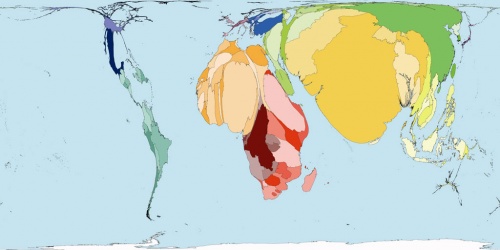Birth - Stillbirth and Perinatal Death
Introduction
The perinatal period is the early postnatal period relating to the birth, statistically it includes the period up to 7 days after birth. Neonatal period is the four weeks/month after birth. Stillbirth and perinatal death can be classified by a number of different systems, all still have "unexplained" or "other" as a potential option. in several systems contribute to many of these deaths. Neonatal deaths include a broader age range of infants who have also died after birth from various causes.
The distorted world map above shows the relative distribution of early neonatal death by country. Note the over-representation of Africa and Asia compared with Europe, USA and Australia. (Image: Dorling D. Worldmapper: The Human Anatomy of a Small Planet PLoS Medicine Vol. 4, No. 1, e1)
Stillbirths with a gestational age of 28 weeks or more are defined as "late fetal deaths".
There are several death classification systems used in different countries around the world, the most recent are the suggested ReCoDe (UK, 2005) and the modified Whitfield (Australia/New Zealand, 2004) systems. A common stillbirth classification is still "unexplained", with recent analysis of data showing fetal growth restriction is a common antecedent. (More? Fetal Origins Hypothesis)
Some Recent Findings
- Stillbirth classification- developing an international consensus for research: executive summary of a National Institute of Child Health and Human Development workshop.[1] "Stillbirth is a major obstetric complication, with 3.2 million stillbirths worldwide and 26,000 stillbirths in the United States every year. The Eunice Kennedy Shriver National Institute of Child Health and Human Development held a workshop from October 22-24, 2007, to review the pathophysiology of conditions underlying stillbirth to define causes of death."
Australian Data
In New South Wales (2002) 613 perinatal deaths were reported.
- Unexplained antepartum deaths: 26.3% of perinatal deaths (or 39.2% of stillbirths)
- Spontaneous preterm labour: 20.6% (less than 37 weeks gestation)
- Congenital abnormality: 16.8%
- Antepartum haemorrhage: 8.5%
- Specific perinatal conditions: 7.3%, of which twin-twin transfusion accounted for 2.3% of deaths
- Hypertension (high blood pressure): 5.5%
- Perinatal infection: 4.4%
- Maternal disease: 4.4%
- Hypoxic peripartum death: 3.8%
Neonatal deaths (four weeks/month after birth)
- extreme prematurity was most common cause (39.6%)
- congenital abnormality (19.3%)
- neurological disease (13.4%)
- cardio-respiratory conditions (11.9%)
- infection (8.4%)
Data: Report of the New South Wales Chief Health Officer, 2004 accessed 19Oct05
USA Data
Leading causes of infant death for 2005:[2]
- Congenital malformations, deformations and chromosomal abnormalities
- Disorders related to short gestation and low birthweight, not elsewhere classified
- Sudden infant death syndrome
- Newborn affected by maternal complications of pregnancy
- Newborn affected by complications of placenta, cord and membranes
- Accidents (unintentional injuries); Respiratory distress of newborn
- Bacterial sepsis of newborn
- Neonatal hemorrhage
- Necrotizing enterocolitis of newborn.
Fetal Death Information
- 2003 Revisions of the U.S. Standard Certificates of Live Birth and Death and the Fetal Death Report. The revision process is generally carried out every 10 to 15 years.
- Maternal, Paternal and medical and health information is collected.
CAUSE/CONDITIONS CONTRIBUTING TO FETAL DEATH
- INITIATING CAUSE/CONDITION
- OTHER SIGNIFICANT CAUSES OR CONDITIONS
- WEIGHT OF FETUS (grams preferred, specify unit)
- ESTIMATED TIME OF FETAL DEATH
- WAS AN AUTOPSY PERFORMED?
- WAS A HISTOLOGICAL PLACENTAL EXAMINATION PERFORMED?
- WERE AUTOPSY OR HISTOLOGICAL PLACENTAL EXAMINATION RESULTS USED IN DETERMINING THE CAUSE OF FETAL DEATH?
Links: 2003 Revisions of the U.S. Standard Certificates of Live Birth and Death and the Fetal Death Report
Conditions Associated with Stillbirth
Based upon the 2007 National Institute of Child Health and Human Development workshop. [1]
Infection
- Severe maternal illness
- Placental infection leading to hypoxemia
- Fetal infection leading to congenital deformity
- Fetal infection leading damage of a vital organ
- Precipitating preterm labor with the fetus dying in labor
Maternal medical conditions
- Hypertensive disorders
- Diabetes mellitus
- Thyroid disease
- Renal disease
- Liver disease
- Connective tissue disease (systemic lupus erythematosus)
- Cholestasis
Other
- Antiphospholipid syndrome
- Heritable thrombophilias
- Red cell alloimmunization
- Platelet alloimmunization
- Congenital anomaly and malformations
- Chromosomal abnormalities including confined placental mosaicism
- Fetomaternal hemorrhage
- Fetal growth restriction
- Placental abnormalities including vasa previa and placental abruption
- Umbilical cord pathology including velamentous insertion, prolapse, occlusion and entanglement
- Multifetal gestation including twin–twin transfusion syndrome and twin reverse arterial perfusion
- Amniotic band sequence
- Central nervous system lesions
References
Reviews
Articles
Search PubMed
Search Pubmed: Stillbirth | Perinatal Death
Glossary Links
- Glossary: A | B | C | D | E | F | G | H | I | J | K | L | M | N | O | P | Q | R | S | T | U | V | W | X | Y | Z | Numbers | Symbols | Term Link
Cite this page: Hill, M.A. (2024, April 30) Embryology Birth - Stillbirth and Perinatal Death. Retrieved from https://embryology.med.unsw.edu.au/embryology/index.php/Birth_-_Stillbirth_and_Perinatal_Death
- © Dr Mark Hill 2024, UNSW Embryology ISBN: 978 0 7334 2609 4 - UNSW CRICOS Provider Code No. 00098G

